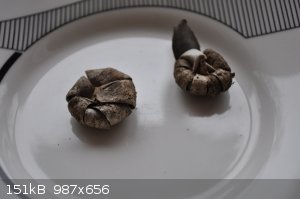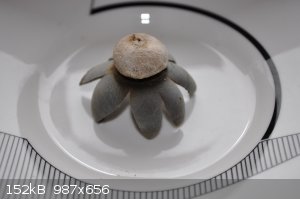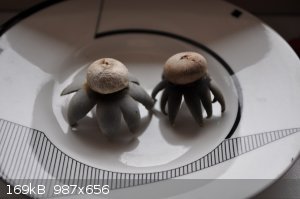| Pages:
1
2 |
Morgan
International Hazard
    
Posts: 1694
Registered: 28-12-2010
Member Is Offline
Mood: No Mood
|
|
Materials science of spore motors
I once brought home some horsetail spores and looked at them under the microscope. When I breathed on the slide with just a puff of humid air they
instantly coiled up, something they do to drop to the ground when moisture is present, a way of finding a good home. Anyway this other article uses
something from nature kind of/vaguely(?) similar perhaps to drive these toys. My spores made an even better performance than the ones seen here, I had
so many more in the field of view and to see them respond with the lightest puff of my breath was something to behold.
Pteridology - Equisetum spores
https://www.youtube.com/watch?v=5EnnYX75Sgg
http://www.popularmechanics.com/science/energy/a16045/evapor...
|
|
|
Morgan
International Hazard
    
Posts: 1694
Registered: 28-12-2010
Member Is Offline
Mood: No Mood
|
|
Here's something vaguely related to the spore motors, little seeds that coil and uncoil using humidity, playing off the ability to expand and
contract. Sir Humphrey Davy had a curious write-up on Erodium.
https://www.youtube.com/watch?v=TOJG5mF6OLs
https://books.google.com/books?id=c4BNAAAAYAAJ&pg=PA372&...
https://en.wikipedia.org/wiki/Erodium_cicutarium
Several good videos each having some little aspect or facet of information.
https://www.youtube.com/results?search_query=erodium
I wonder if you could shred the fibers and then make some faster working device using a bundle of these Erodium seed fibers arranged in some way, get
the surface area up so as to flex more suddenly?
In other news, I came across this high tension dispersal method the sandbox tree uses which sounds fairly energetic.
http://www.unbelievable-facts.com/2013/10/theres-tree-covere...
http://www.britannica.com/plant/sandbox-tree
"For sheer ballistic verve, we look to another tropical plant, one that is also cultivated in South Florida. It is Hura crepitans, the sandbox tree
of the Euphorbiaceae. It has capsules the size and shape of tangerines. Each fruit has many segments, just as does a tangerine, and each fruit segment
contains a seed the size of a nickel. When the fruits burst open, they shoot their seeds nearly 150 feet, accompanied by an explosive noise that is
said to sound like the discharge of a rifle!"
http://www.virtualherbarium.org/gardenviews/GoingBallistic.h...
https://www.youtube.com/watch?v=x_OAS-K0feI
http://www.ebay.com/itm/Hura-crepitans-SEED-Dynamite-or-Sand...
http://www.ebay.com/itm/Extremely-rare-seeds-Hura-crepitans-...
[Edited on 30-6-2015 by Morgan]
|
|
|
Morgan
International Hazard
    
Posts: 1694
Registered: 28-12-2010
Member Is Offline
Mood: No Mood
|
|
Another tidbit on the forces produced by the sandbox tree seed pod.
[I chanced upon a couple of seed pods during my daily early morning stroll along the banks of the Siem Reap River. They looked like exquisitely carved
miniature pumpkins; nature’s very own decorative art, so I took them home and placed them on a shelf in my apartment.
This was not a move welcomed by Khmer True Love. She took a more derisive approach, regarding the seeds as mere junk that had no place in the home,
and muttered at length about the inherent craziness of barangs.
Then, in the wee hours of the morning, the first of the pods dynamically exploded, followed by the sounds of crashing glass and the clatter of falling
wood.
It sounded like a gun had been fired in the room, and the shrapnel from the exploding pod blew away items on the shelf including blown glass figurines
from Battambang.
Khmer True Love awoke and screamed. I jumped from bed and hopped about in a panic until I realised we weren’t the victims of a home invasion.
It gradually became evident that the pod was the villain.
Khmer True Love was far from happy, but we both settled down to regain sleep when “Bang!” – the second seed pod went off to even more dramatic
effect.
Next morning, in between further tirades from Khmer True Love about intolerable barang craziness, I managed to identify the source of this botanical
outrage.
Phnom Penh landscape designer Bill Grant said the seed pods were from the sandbox tree, or Hura crepitans tree.]
http://www.phnompenhpost.com/siem-reap-insider/seedy-encount...
|
|
|
aga
Forum Drunkard
    
Posts: 7030
Registered: 25-3-2014
Member Is Offline
|
|
Quote: Originally posted by Morgan  | | I once brought home some horsetail spores and looked at them under the microscope. When I breathed on the slide with just a puff of humid air they
instantly coiled up |
You're clearly nuts Morgan, but you're the kind of nuts i like 
At what magnification did you observe that ?
I have a stereo microscope, just no idea if i could see what you saw.
|
|
|
Morgan
International Hazard
    
Posts: 1694
Registered: 28-12-2010
Member Is Offline
Mood: No Mood
|
|
I had an old microscope that had the highest magnification lens crunched accidentally into the slide so it had to have been one of the lower powers.
It's stunning to see how responsive the spores are to just a whiff of humid air.
When so many elators closed up in the field of view in a blink, it raised the hair on my arms. I was expecting the effect, but just not so vividly
syncronized in such number, like little transistorised dust specks switching on and off. It was such an easy thing to do.
Here's one other "flowery" account of an exploding seed pod, less powerful than the sandbox tree, but just as curious.
[I was awakened out of sleep by an unknown sound in my living room. Not a small sound--not a creaking timber or a
mouse's scurry--but a sharp, rending explosion as though an unwary foot had been put down upon a wine glass.
I had come instantly out of sleep and lay tense, unbreathing. I listened for another step. There was none.
Unable to stand the suspense any longer, I turned on the light and passed from room to room glancing uneasily
behind chairs and into closets. Nothing seemed disturbed, and I stood puzzled in the center of the living room
floor. Then a small button-shaped object upon the rug caught my eye. It was hard and polished and glistening.
Scattered over the length of the room were several more shining up at me like wary little eyes. A pine cone that
had been lying in a dish had been blown the length of the coffee table. The dish itself could hardly have been
the source of the explosion. Beside it I found two ribbon-like strips of a velvety green. I tried to place the two
strips together to make a pod. They twisted resolutely away from each other and would no longer fit.
I relaxed in a chair, then, for I had reached a solution of the midnight disturbance. The twisted strips were
wisteria pods that I had brought in a day or two previously and placed in the dish. They had chosen midnight to
explode and distribute their multiplying fund of life down the length of the room. A plant, a fixed, rooted thing,
immobilized in a single spot, had devised a way of propelling its offspring across open space. Immediately there
passed before my eyes the million airy troopers of the milkweed pod and the clutching hooks of the sandburs.
Seeds on the coyote's tail, seeds on the hunter's coat, thistledown mounting on the winds--all were somehow
triumphing over life's limitations. Yet the ability to do this had not been with them at the beginning. It was the
product of endless effort and experiment.]
“HOW FLOWERS CHANGED THE WORLD”
by Loren Eiseley
http://www.myteacherpages.com/webpages/DLuff/files/how%20flo...
exploding wisteria pods
https://www.youtube.com/watch?v=RrBzWyZUMhc
|
|
|
aga
Forum Drunkard
    
Posts: 7030
Registered: 25-3-2014
Member Is Offline
|
|
Ok.
Slightly bored aready, as you're banging on about the same pheneomena a lot.
That must mean that i do not grasp the enormity of what you understand by these phenomena.
Yes, you have noticed that organic matrices can change shape in response to humidity.
They have done that for rather a long time.
In Late Summer i have been 'shot at' a few times by wild pea pods.
Please bring it to a Point either publicly or via U2U.
Eyes and Ears are Open, just not understanding where you are going with this.
|
|
|
Morgan
International Hazard
    
Posts: 1694
Registered: 28-12-2010
Member Is Offline
Mood: No Mood
|
|
I was interested in the spore motors or moisture muscles that used H2O as the Popular Science article talked about in my first post. The idea was to
search for other examples besides their bacteria spores in order to get an idea of what's been done by man or nature, sort of a materials science
endeavor. It's not immediately obvious even to me what I'm looking for, but sometimes lateral thinking is what movitates me, not having to define
exactly what the goal is or how to implement it. So I was trying to drum up some ideas and interest, to see what might come about. It could be
something practical or merely a piece of kinetic art, which in some sense is also practical.
Puskás Gép/Puskas Water Engine
https://www.youtube.com/watch?v=O4ZFDXAaJfY
Quite a bit of spin for a plant.
"Angular velocities are high, attaining at least 15,000 rpms in one case."
http://onlinelibrary.wiley.com/doi/10.1111/j.1469-8137.1977....
|
|
|
Morgan
International Hazard
    
Posts: 1694
Registered: 28-12-2010
Member Is Offline
Mood: No Mood
|
|
I thought it was funny how the guy in this link wears gloves and his coat backwards, along with eyewear to photograph the seed pods fracturing. He
didn't have the right slow motion camera or a trigger mechanism to capture it in more detail but it was kind of interesting to see his setup. In some
of the clips it's kind of like watching someone handle a high explosive, there's a certain respect he's showing for the seed pods. I'm curious about
the quick shake of the pod technique.
"Warning: we do not recommend you try this yourself. The sap of the seed pod is toxic beyond belief. The explosion is violent (and loud). The sharp
edges of the seed chambers could easily puncture your eyeball or otherwise wound and scar your body. We are inherently curious, however, and wanted to
experience the explosion in-person."
http://www.maya-ethnobotany.org/toxic-intoxicating-halucinog...
Ask Nature
http://www.asknature.org/strategy/9183fe65870e489f0c556bb9a8...
evaporative tension
http://www.asknature.org/strategy/972959eb83b6ba2d26ed82b05f...
Poisonous Plants and Animals of Florida and the Caribbean
https://books.google.com/books?id=C8xJE2NfQpIC&pg=PA174&...
"The fruits explode violently. One removed from the tree and placed in a dry room will explode entertainingly at a random point over the following
weeks, followed by a clattering as the seeds rebound from the walls and ceiling."
http://herbaria.plants.ox.ac.uk/vfh/image/index.php?item=886
[Edited on 16-7-2015 by Morgan]
|
|
|
eesakiwi
Harmless

Posts: 27
Registered: 10-8-2005
Member Is Offline
Mood: drawnout
|
|
Those spores remind me of the ' morgellans' hairs etc.
And its a complete coincidence that the OP is called Morgan....
I have picked these sorts of hairs out of my skin before, but I have been 90% sure its just cotton fibres and such.
Of the coloured hairs are the same as my pillow case or clothing.
But, I have found hairs that do the exact same thing as the spores in the video. That was from breathing on then, I actually figured it was either the
heat of my breath or the extra CO2 in it that was making them move, I did't think of humidity.
|
|
|
Morgan
International Hazard
    
Posts: 1694
Registered: 28-12-2010
Member Is Offline
Mood: No Mood
|
|
I suppose it's well-known and commonplace for certain shapes and materials to respond to heat, humidity, air currents, static electricity, or a
combination of these things. These bonito flakes were kind of an exotic application.
Katsuobushi / moving fish flakes
https://www.youtube.com/watch?v=554eVy5poFg
https://www.youtube.com/watch?v=POQQ8lhH0M4
https://en.wikipedia.org/wiki/Katsuobushi
Heat driven nylon muscles
http://io9.com/scientists-just-created-some-of-the-most-powe...
The Story of Electricity preview - BBC Four
https://www.youtube.com/watch?v=fYQVVwFj5c8#t=31s
|
|
|
aga
Forum Drunkard
    
Posts: 7030
Registered: 25-3-2014
Member Is Offline
|
|
Quote: Originally posted by Morgan  | | It's not immediately obvious even to me what I'm looking for, but sometimes lateral thinking is what movitates me, |
Now tou're talking !
OK. How do i get my hands on some of them to have a look ?
First question is 'where does the energy come from ?'
Now that is certainly worth a look.
[Edited on 26-7-2015 by aga]
|
|
|
Morgan
International Hazard
    
Posts: 1694
Registered: 28-12-2010
Member Is Offline
Mood: No Mood
|
|
If you kept the sandbox seed pods moist, maybe you could keep them for years according to this Scientific American article. Then, went you wanted an
explosion, let one dry out. It would be fun to have a bag of them if you lived in a place you could collect them. The magazine was approached for a
suggestion of how one might keep the pods from exploding, to use them as an ornament. Their response was kind of funny, recommending copper plating
the pod, as they do baby shoes perhaps. ha
https://www.youtube.com/watch?v=NbKRQfOlhhI
"The nuts stand exporting and occasionally do not explode for several months." The article mentions pods from another plant that do just the opposite,
explode when wet.
https://books.google.com/books?id=cKYzAQAAMAAJ&pg=PA348&...
"When it dries out and finally explodes, it hurls its seeds for distances of over forty feet and the bang it makes as it does so is quite enough to
convince nervous strangers in the forest that they are under attack."
http://www.asknature.org/strategy/972959eb83b6ba2d26ed82b05f...
If you look at a pod there are little air vents at one end of the pod looking sort of like certain poppy capsules and the seeds can be heard to rattle
inside. I was wondering what goes on when it explodes, if there's a sudden low pressure event where the air rushes to fill a partial vacuum created by
the separation of the pod segments or what? Too bad there isn't a good slow motion capture of the event.
|
|
|
aga
Forum Drunkard
    
Posts: 7030
Registered: 25-3-2014
Member Is Offline
|
|
So where do i get some ?
|
|
|
Morgan
International Hazard
    
Posts: 1694
Registered: 28-12-2010
Member Is Offline
Mood: No Mood
|
|
Where Does the Sandbox Tree Grow?
"The sandbox tree is native primarily to tropical parts of South America and the Amazonian Rainforest, although it is sometimes found in tropical
parts of North America. In addition, it has been introduced into Tanzania in Eastern Africa, where it is considered invasive."
"The tree can only grow in frost-free areas similar to U.S. Department of Agriculture plant hardiness zones 10 and 11. It needs moist, sandy-loamy
soil in an area with full or partial sun."
"You should never plant a sandbox tree. It is too dangerous to have around people or animals, and when planted in isolated areas it is likely to
spread."
http://www.gardeningknowhow.com/ornamental/trees/sandbox-tre...
A nice looking pod.
http://blackwalnut.npust.edu.tw/wp-content/uploads/xdcm/bd/N...
"Most of these movements are slow, even imperceptible, and took the patient eye of naturalists like Charles Darwin to be revealed (Darwin
and Darwin, 1880). However, some movements are so fast
that they compete in speed with those encountered in the
animal kingdom and require the most advanced high-speed
cameras to be glimpsed."
"Many of these systems have minimal water content when triggered and
come close to the ultimate physical limit for fast motion, that
set by the speed of elastic waves within solids."
http://jxb.oxfordjournals.org/content/early/2013/08/02/jxb.e...
[Edited on 27-7-2015 by Morgan]
|
|
|
aga
Forum Drunkard
    
Posts: 7030
Registered: 25-3-2014
Member Is Offline
|
|
So where do i get some horsetail spores instead ?
It's going to be really quite difficult to experiment with these things if i can't actually get some.
E.g. can you post me some if i send you some money ?
|
|
|
Morgan
International Hazard
    
Posts: 1694
Registered: 28-12-2010
Member Is Offline
Mood: No Mood
|
|
There may be laws against exporting invasive species. I went looking for some horsetails today but had no luck. There are however common garden
centers in the U.S. such as Lowes and Home Depot that sell them. But it seems likely there would be plant stores in Spain that also sell them along
with all the other things people like to grow. And I read at least one kind of horsetail grows there.
"Equisetum giganteum runs...no, it gallops, so do not plant it in the ground in warm climates. In containers, seal the drainage holes if escaping into
the ground is possible."
http://www.plantdelights.com/Equisetum-giganteum-El-Tabacal-...
"This weed is the worst I've ever dealt with. It spreads underground and via spores."
"Now before we proceed to try and destroy it, let us first faintly praise this living fossil that is among the oldest plants in the world. (How old is
it? So old that much of the coal we burn today was once horsetail.) The plant contains such large amounts of silica that it has served as a kind of
natural sandpaper for millennia. Some gardeners deliberately grow it next to birdbaths so they can use the gritty plant to clean the saucer between
fillings, and it's better than Brillo at scrubbing pots and pans. It's also attractive enough—kind of like a miniature pine tree —that it's been
planted deliberately as an ornamental. (The people who did so probably felt pretty good about their decision the first few years, as it's very slow to
establish. But when it does get going, you become a horsetail farmer.) "
http://www.gardensalive.com/product/horsetailthe-weed-that-s...
[Edited on 27-7-2015 by Morgan]
|
|
|
aga
Forum Drunkard
    
Posts: 7030
Registered: 25-3-2014
Member Is Offline
|
|
If i get some alien bio material it will be handled safely, and destroyed if necessary, especially in preference to releasing it into my part of the
world.
This should be Standard Protocol for anyone, no matter what the seeds are, where they come from or where you live.
https://en.wikipedia.org/wiki/Fallopia_japonica
Will you send me some or not ?
To re-itterate : i will pay the costs.
To be totally frank, if you are a Scientist, please do some science on this subject instead of being all google obsessed.
Links to other people's work are great.
A detailed description of Your Work would be even more fascinating.
A gut feeling tells me that you've discovered something interesting, and should be pursued.
[Edited on 27-7-2015 by aga]
|
|
|
Morgan
International Hazard
    
Posts: 1694
Registered: 28-12-2010
Member Is Offline
Mood: No Mood
|
|
I don't have any spores. But yes they are interesting to watch in the videos how they respond to moisture. I can't imagine weaving them into thread or
anything like that, they are so small and I don't have any hopes of making anything with them other than the knowledge of that property. Have you
looked into any plant stores in your area?
One scientific article that made a hygrometer out of a human hair stated everyone who has had a bad hair day knows humidity can affect hair. So I
think the best approach would be to find something feasible to work with if you want to toy with "tension motors" as one plant journal referred to the
characteristic.
[Edited on 28-7-2015 by Morgan]
|
|
|
Morgan
International Hazard
    
Posts: 1694
Registered: 28-12-2010
Member Is Offline
Mood: No Mood
|
|
A clever use for this material. Maybe a lifelike butterfly with wings made of cellophane would do as well. The moisture source could be in the shape
of some flower for artistic effect.
Fortune Fish Puskas Engine
https://www.youtube.com/watch?v=aqo9wV39BlY
Spore motor review/abstract
a) Water confined to nanoscale cavities, conduits and surfaces within hygroscopic materials can induce large pressures in response to changing
relative humidity. (b) A scanning electron microscopy image of the cross-section of a B. subtilis spore. Spores exhibit strong mechanical response to
changing relative humidity18 by absorbing and releasing moisture. (c) A false-coloured s.e.m. picture of spores (grey) deposited on an
8-micrometre-thick polyimide tape (yellow). (d) The spore-coated films bend and straighten in response to changing relative humidity. (e) Patterning
equally spaced spore layers on both sides of the plastic tape creates linearly expanding and contracting structures. (f) Stacking the tapes in e with
air gaps between them results in a material that can be scaled in two dimensions without compromising hydration/dehydration kinetics. (g) A shutter
mechanism can create oscillations. (h) Photo of a device that exhibit self-starting oscillatory movement when placed above water. (i) Rotary motion
can lead to cyclical changes of relative humidity experienced by the spores. The increased curvature on the dry side shifts the centre of mass of the
entire structure away from the axis of rotation and creates torque. (j) Photo of a device whose continuous rotation is powered by evaporation from the
wet paper within the device.
http://www.nature.com/ncomms/2015/150616/ncomms8346/fig_tab/...
http://www.nature.com/ncomms/2015/150616/ncomms8346/full/nco...
[Edited on 1-8-2015 by Morgan]
|
|
|
Morgan
International Hazard
    
Posts: 1694
Registered: 28-12-2010
Member Is Offline
Mood: No Mood
|
|
This isn't a spore motor but it's another hygroscopic motor of sorts in the plant world. One evening when walking I brought one of these home and put
it on a dish near a cracked window. The next morning I was surprised to see it had wrapped itself into a ball. So I gathered another and let it dry,
then rehydrated both again. It takes about 1/2 an hour for the effect to bloom back to an open state. The effect has been done several times now with
these two.
I was reading they can be used for table decorations and some can separate from the soil and when dry roll like a tumbleweed and revert to an open
state in moist areas or when the conditions favor spore release. When I rehydrated them, the delicate puffball center would be mashed somewhat but
with a light puff of my breath perhaps ~5 centimeters away reinflated perfectly again for the photos. One of the rays on one earthstar became cocked
for some reason and always sticks instead of springing to and fro. I guess I could flex it when wet to see if that would fix it, get the bow out of it
to allow it to close.
https://en.wikipedia.org/wiki/Astraeus_hygrometricus
     
[Edited on 17-2-2021 by Morgan]
|
|
|
karlos³
International Hazard
    
Posts: 1520
Registered: 10-1-2011
Location: yes!
Member Is Offline
Mood: oxazolidinic 8)
|
|
Star puff-mushrooms!
Or weather-stars as we call them here, because they act like a primitive barometer.
|
|
|
Cezium
Harmless

Posts: 39
Registered: 5-1-2015
Member Is Offline
Mood: No Mood
|
|
Not exactly hygroscopic motor but during EANM18 I saw interesting presentation on molecular motors by dutch prof. Feringa.
something like this:
youtube.com/watch?v=nkZxymL2Whg
youtube.com/watch?v=vELfuiUpKM0
|
|
|
Morgan
International Hazard
    
Posts: 1694
Registered: 28-12-2010
Member Is Offline
Mood: No Mood
|
|
Maybe of interest - motive subject matter. From the link in the video.
"Rapid plant movements, such as the “snap” of a Venus fly trap, are striking character gains that have led to trait innovations such as carnivory.
However, the majority of fast motions in plants and fungi are adaptations for dispersal. Catapulted pollen or synchronous puffs of fungal spores are
evolutionary solutions to the problem drag poses to getting small particles airborne."
Biology behind seed dispersal by explosion
https://youtu.be/Fzgmh9jUbyg
A cavitation launched spore among other topics if you scroll dow.
https://journals.plos.org/plosone/article/figures?id=10.1371...
|
|
|
Morgan
International Hazard
    
Posts: 1694
Registered: 28-12-2010
Member Is Offline
Mood: No Mood
|
|
Maybe of interest - motive subject matter. From the link in the video.
"Rapid plant movements, such as the “snap” of a Venus fly trap, are striking character gains that have led to trait innovations such as carnivory.
However, the majority of fast motions in plants and fungi are adaptations for dispersal. Catapulted pollen or synchronous puffs of fungal spores are
evolutionary solutions to the problem drag poses to getting small particles airborne."
Biology behind seed dispersal by explosion
https://youtu.be/Fzgmh9jUbyg
A cavitation launched spore among other topics if you scroll down.
https://journals.plos.org/plosone/article/figures?id=10.1371...
|
|
|
Morgan
International Hazard
    
Posts: 1694
Registered: 28-12-2010
Member Is Offline
Mood: No Mood
|
|
I found this clip of Astraeus hygrometricus expanding. It's method of curling up in dry conditions protecting the spores and even having the ability
to be blown and roll like a tumbleweed until detecting moist evironments is interesting in that the rays unfold when finding water, whereas as tiny
horsetail spores sailing in the air collapse or fold in their fast response elaters when reaching humid habitats. One expands and the other contracts
- yet to achieve the same goal.
Astraeus hygrometricus
https://www.youtube.com/watch?v=RTFDccssHH8
Horsetail spores
https://www.youtube.com/watch?v=h-4rl4lJpx8
[Edited on 23-2-2021 by Morgan]
|
|
|
| Pages:
1
2 |